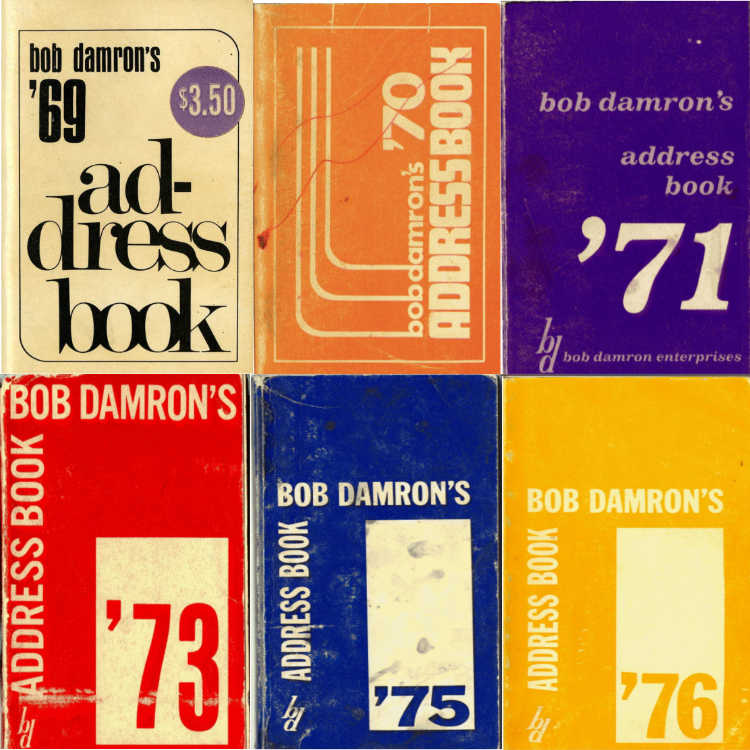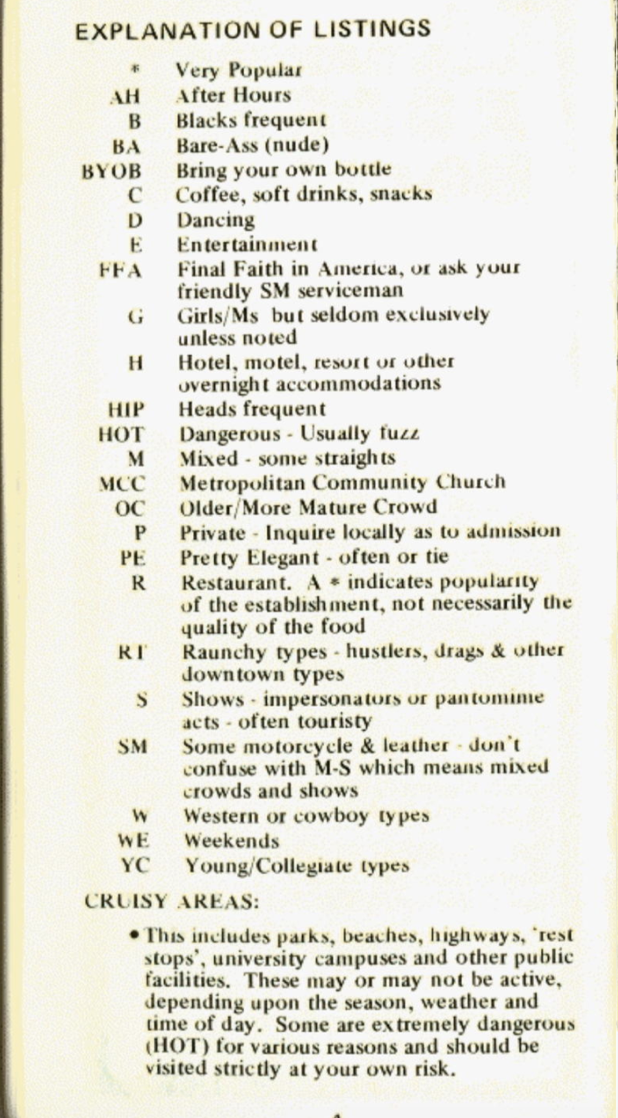Mapping the Gay Guides
Visualizing Queer Space and American Life
Welcome to Mapping the Gay Guides!

Figure 1. Covers from Damron’s Address Book
While operating one of his many gay bars in the 1960s, Bob Damron started a side project publishing gay travel guides that featured bars like his. Called the Bob Damron Address Books, these guides proved popular and became a valuable resource for gay travelers looking for friends, companions, and safety.
First published in an era when most states banned same-sex intimacy both in public and private spaces, these travel guides helped gays (and to a lesser extent lesbians) find bars, cocktail lounges, bookstores, restaurants, bathhouses, cinemas, and cruising grounds that catered to people like themselves. Much like the Green Books of the 1950s and 1960s, which African Americans used to find friendly businesses that would cater to black citizens in the era of Jim Crow apartheid, Damron’s guidebooks aided a generation of queer people in identifying sites of community, pleasure, and politics.
Damron’s guidebooks were part of a growing interest in gay travel guide publications that began in the early 1960s. Bob Damron wasn’t the only entrepreneur looking to offer gay consumers listings of queer friendly places. Guy Strait published the first edition of The Lavender Baedeker in 1963, an extension to his already popular newspaper in San Francisco entitled Citizen’s Guide. Other publishers followed suit, including Guild Guide to the Gay Scene and World Report Travel Guide, published not in the gay mecca of San Francisco but rather in New York. Despite stiff competition from these early publishers and later “copycats” (as Damron often saw them), Damron’s guidebooks were perhaps the most extensive and long running of any of the early gay travel guides. In fact, unlike all his initial competition, Damron’s guides lasted until 2021. While the internet age ultimately contributed to the downfall of the guides (with much of the guidebook’s information inside easily accessible on the web for free), it’s worth highlighting that the Bob Damron Address Books existed for nearly six decades. It suggests an enduring and active queer travel community that never was strictly confined to a closet.

Figure 2. Explanation of Listings from Damron’s Address Book, 1976
To be sure, Damron’s guidebooks are not a perfect source base. Since these guides were aimed mostly at gay men, they overlook large swaths of queer culture. Little in the pages of Damron offers insight into the vibrant culture of trans people, for example. In addition, Bob Damron’s Address Books largely understand the gay world from the perspective of a San Franciscan, white gay man. They often reflect coastal biases, seeing places outside the queer meccas of New York or San Francisco as primitive. Even so, the Damron guidebooks are a relatively prolific set of listings that offer users insight, however incomplete, into the queer world of the past.
Mapping the Gay Guides believes that mapping Damron’s guidebooks can offer valuable insight into the queer world beginning in the 1960s and into the present. Our research team has begun turning the thousands of listings within the guides into usable, functioning data to allow researchers to make connections between historical queer communities. Mapping this data allows us to display the distribution of locations and explore the growth of the queer communities over time. In the U.S. South, for example, you can explore 154 queer spots across twelve state in 1965 to over a thousand locations in those same states by 1980. Damron’s use of letters and symbols to designate certain features of bars (the “B” for “blacks frequent,” for example) allows users to navigate through nuances in queer geography. Mapping the Gay Guides turns the incredible textual documents of gay travel guides into accessible visualizations, useful in exploring change in queer communities over time.
The importance of this project is widespread. The vast majority of the listings within the first two decades of the guidebooks’ publication are no longer in existence. Little remains of the queer world found in the pages within the Damron Address Books that began in 1964. In addition, since queer businesses like bars or bathhouses or the informal nature of cruising locations often leave few historical records, the queer history of local communities can often seem invisible or nonexistent. Mapping the Gay Guides intends to correct our cultural erasure of historical geography. Queer people have actively sought and found places of acceptance for decades, even in places regarded as homophobic or ignorant.
How to Use this Site
There are two main ways to explore the content on this site. First, you can look at our map which displays the location of each entry in Bob Damron’s Address Books between 1965 and 1985 along with information about how the location was classified by the Damron Corporation. Drop-down menus and a date slider on the visualization allow you to filter the data by state or territory, amenity feature, location type or year. Our methodology includes more information on each of these categories as well as on the choices made in digitizing our source data.
The second way to explore content on the site is through our “Vignettes,” or short case studies based on the visualizations. Each Vignette explores some aspect regarding the history of LGBTQ spaces in the United States and includes historical context and analysis.
We’ve recently released another 25,000+ entries from 1981-1985 and have more releases planned soon. Sign up here to receive updates when new data and materials launch!
Originally Published: December 14, 2019 | Last modified: October 7, 2022